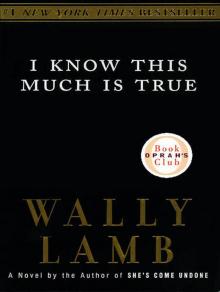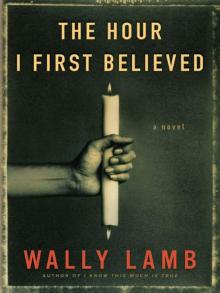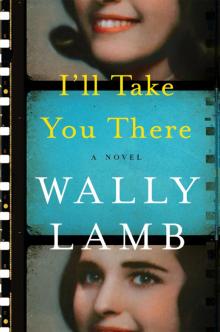- Home
- Wally Lamb
I'll Take You There
I'll Take You There Read online
DEDICATION
For feminists everywhere, of every era
CONTENTS
Dedication
Prologue
One
Two
Three
Four
Five
Six
Seven
Eight
Nine
Ten
Eleven
Twelve
Thirteen
Fourteen
Fifteen
Sixteen
Seventeen
Eighteen
Acknowledgments
About Wally Lamb
Also by Wally Lamb
Credits
Copyright
About the Publisher
PROLOGUE
I turned sixty earlier this year, an age that brings deficits, of course: creaky knees, a temporary inability to remember familiar people’s names, a second colonoscopy. But there are benefits to reaching this age, too. One is wisdom, or so they tell me. Another is the senior citizen discount at Dunkin’ Donuts—once you survive the shock of being asked if you’re eligible, or more shockingly, the cashier’s assumption that you’re eligible without asking. Geezerdom’s got a third perk, too. Let’s call it a bemused appreciation for how ironic life can be. Take, for instance, adult diapers: from Pampers we came, to Depends we shall return. Ironic, no? It’s the same with tears. We cry easily when we’re kids, not so much as grown-ups. Then, at about the time those AARP magazines start showing up uninvited in the mailbox, the lachrymal glands come alive again. Mine do, anyway. I can tear up at sappy commercials, sentimental newspaper articles, Facebook posts about some family’s decision to have their dog put down. And when the TV news shows one of those surprise reunions between a soldier returning from the war and his kids—or her kids—man, I lose it.
Hmm? Oh right—excuse my manners. I’m Felix Funicello. If you’re wondering why my surname sounds familiar, it’s probably because my family had a famous cousin. Annette Funicello? The Mickey Mouse Club? Beach Blanket Bingo? No? Well, never mind. But mark my words: someday when you’re my age, you’ll mention Miley or Bieber and some future youth will look at you blankly and say, “Who?” Take it from me. The accelerating passage of time will astound you.
So where was I? Oh yeah, tears. I was on a plane a while back, flying out to California for a film conference, and one of the in-flight movies was that Disney-Pixar film, Up. So I start watching it. Studying it, you know, because I’m a film professor—and the author of three scholarly books on film history—and these Disney-Pixar flicks are considered by some to be both entertainment and art. So what did I care what that teenage boy sitting next to me with the earplugs and the fauxhawk and the skateboarding magazine in his lap thought about some old dude watching a cartoon? What’s it to him, right? But then, when the film does that “married life” sequence between the old guy, Carl, and his wife, Ellie—shows them from the time they meet as kids to when they wed, lose their baby, grow into middle age, and then, in old age, she dies—I began blubbering. Over a cartoon movie, for crying out loud. And in my peripheral vision, I could see the fauxhawk kid staring at me. I felt like saying to him, “Wait until you’re my age, you little doofus, and we’ll see how dry-eyed you stay when you watch a sequence like this. Or De Sica’s The Bicycle Thief, or Schlesinger’s Midnight Cowboy, or Jim Sheridan’s In the Name of the Father instead of Iron Man 12 or X-Men 27 or whatever the hell last summer’s pubescent blockbuster was. Maybe by then you’ll have picked up a little cinematic discernment. And by the way, your mouth-breathing’s annoying and your haircut looks kind of stupid.” But when I look over at him, I see that he’s not watching me watching the film. He’s watching the film. And then he taps me on the arm and says, “This movie rocks. That part they just showed? First time I saw it, I was like crying.”
By the time you’re sixty, you have, of course, encountered the reality that life can be unfair or even tragic. Bad things can happen to good people. Bad people sometimes do thrive and get away with terrible transgressions for which they should be punished, cosmically or legally. But life can also be amusing—hilarious even. Beautiful and sublime. All you have to do to realize that is take out those tattered family photo albums or pop in that VHS tape from 1983 or thread the old film projector, that vintage opto-mechanical Bell & Howell from the early sixties, say, and watch those home movies your dead dad took back when you and your siblings were kids and he was still in his thirties, and he aimed, shot, and captured for posterity who you all were back then.
That’s what movies are, right? Thousands of still pictures taken months or years or decades before—streams of images burned onto celluloid that are reeled in front of a lamp and projected onto a screen, allowing us the illusion that they’re alive. Flickers of light and dark. Brightness and shadow that won’t stand still—like life itself.
ONE
Hooray for Hollywood! That screwy ballyhooey Hollywood . . .
Oops. That’s my phone. Excuse me for a minute, will you?
“Hello?”
“Hi.”
Weird pause. “And, uh, who is this?”
“Kenneth.”
“Kenneth . . . ?” That REM song starts playing in my head. What’s the frequency, Kenneth? Is your Benzedrine uh-huh . . .
“From the Monday night movie club.”
“Oh. Hey, Kenny.” (Speaking of what’s the frequency?) “What’s up?”
“I lost that schedule you gave us, so I wanted to know what movie we’re seeing this coming Monday night. Because I can’t find the schedule and I think my mother might have thrown it out, but she says she didn’t. She told me to decide whether to go to our group or to a graduation she wants me to go to.”
Kenny’s a community college kid going on middle-aged, which more or less puts him in the same demographic as the rest of the gang in the Monday night film group I run. Interesting young man, though—movie-obsessed, although he’s a specialist, not a generalist. He’s the only twenty-one-year-old I know who can speak in detail about the oeuvre of Russ Meyer, the breast-obsessed director of such films as Faster, Pussycat! Kill! Kill!, Wild Gals of the Naked West, Mondo Topless, and Beneath the Valley of the Ultra-Vixens. If you want to talk Russ Meyer, Kenny’s your man.
“We’re going to be watching Ben-Hur,” I tell him. “Not the Charlton Heston one. The silent film from the twenties with Ramon Novarro and Francis X. Bushman. It’s pretty amazing visually, given the limitations of moviemaking back then. It’s got the sea battle, the chariot race, a cast of thousands. A lot of the big stars from that era are in the crowd scenes. The Barrymores, the Gish sisters, Mary Pickford and Douglas Fairbanks.” None of whom he’s ever heard of, I’m sure. Kenny’s somewhat dismissive of anything that came before Russ Meyer’s first film, The Immoral Mr. Teas, a nudist comedy.
“Wasn’t Charlton Heston in Bowling for Columbine?” he asks.
“Was he, Kenny? Let me think.”
“He was. Michael Moore went to his house and tried to interview him because he was the one who said they were going to have to grab his guns out of his ‘cold, dead hands.’” Kenny worships at the altar of Michael Moore, too, which is not something I necessarily would have assumed.
“You’re right. Now I remember. But Heston was a big action star before he became an NRA pitchman. Westerns, war movies, Bible epics. He won the Oscar for Ben-Hur and he had the lead role in the original Planet of the Apes.”
“He was in Touch of Evil, too. He had a mustache.”
“I forgot about that one. Classic film noir, right?”
“Silent movies don’t really interest me. I guess I’ll go to the graduation.”
“Okay, sure. We’ll see you next time then. Who’s g
raduating?”
“Me.”
“Oh. Well, sure then. You should definitely go to your own graduation.”
“That’s what my mother says, too.”
“And congratulations. I hadn’t realized—”
Click. End of conversation.
The Monday night movie club? Kenny came on board about a year ago, but I’ve been getting together with my little band of regulars for the past several years. First I introduce some great old classic—Stagecoach, say, or Sunset Boulevard—and talk about the technical innovations or camera angles they used, the historical or cultural significance of the story, the dialogue, the director’s other films. Then I screen it for them, after which we talk about what we’ve just seen. I don’t so much steer the conversation as let it go wherever it wants to. We meet in New London at the old Garde Theatre. They got some significant grant money a while back that allowed them to renovate and refurbish it and install state-of-the-art sound and digital projection, but they hung on to all the old equipment, too, and that’s what I prefer to use. For authenticity’s sake, you know? It’s called film, right? As in celluloid, not pixels. It’s getting harder to find distributors of the old film reels, and the shipping costs for those clunky metal canisters are ridiculous. But to me it’s worth it. If you’re going to show an audience the vintage stuff, they might as well see it the way it was meant to be seen, not with some technology that came along sixty or seventy years into the future.
I really enjoy my Monday night regulars—more so than, say, the college kids I teach at Hunter. Of course, those students have their charms, too, if not a whole lot of life experience yet. But by and large, the Monday nighters have some considerable mileage on their odometers so they’ve seen more, know more. Marilyn has her SAG card and was on a couple of Law & Orders, once as a socialite and another time as a corpse. JoAnne and Murray’s daughter is a big-time casting director. Reggie fell in love with old movies via TCM while he was doing a six-year bid in prison for check kiting. He carpools with Tony, a cop who retired with a work-related disability, paid for culinary school with his settlement, and opened a gluten-free bakery. Ed, a weightlifter who was once Mr. Rhode Island, mans the projection booth for me, hitting the foot pedal so that as reel one runs out, the second projector starts running reel two. They’ll start out talking about the film we just watched and end up talking about themselves. It’s the same with me. Hey, movies are touchstones, right? Triggers that have the power to transport us back in time. Songs can do that, too, of course. And music videos. The other day, I was looking for something on YouTube and I stumbled onto that old Tina Turner video for “What’s Love Got to Do with It.” Remember that one? Tina’s strutting through some urban landscape wearing her jean jacket and shaking that wild hairstyle she had back then, doing that sexy little two-step of hers. What’s love got to do got to do with it? / What’s love but a sweet old-fashioned notion? I watched that video and bam! It was 1984 all over again. Ronald Reagan in the White House and Cheers on TV and my then-wife Kat “power-dressing” for work like Joan Crawford in those suits with the shoulder pads. We couldn’t really afford it back then, but I bought one of those big-ass camcorders. Lugged it around on my shoulder so that I could get a videotaped record of our daughter, Aliza, taking her first steps, blowing out her birthday candles. Of course, VHS has gone the way of the dodo bird and the 35-millimeter film projector now. One of these days, I’m going to get those old tapes converted before—
Hooray for Hollywood! That screwy ballyhooey Hollywood . . .
Excuse me. Ah, it’s Aliza, speaking of whom. “Hey there, kiddo.”
“Hi, Daddy. Are you busy?”
“Too busy to talk to you? Never! How’s it going? Everything copacetic down there in Queens?”
“At the apartment, yes, although I didn’t realize what a slob Jason is until he moved in. Dirty dishes in the sink, toothpaste dots all over the medicine cabinet mirror. He’s almost as bad as Jilly.”
Jason is her new boyfriend, a New York University Special Collections librarian and part-time slam poet with whom she’s sharing her bed. According to my daughter, “Jason’s almost as big a film nerd as you, Daddy.” Jilly is one third of the trio of young career women with whom Aliza shares a four-bedroom apartment in the Astoria section of Queens. By New York standards, the place is huge. Jilly’s real name is Jillian and there’s Jordana and Jen, too, although I can never keep it straight which one is which. They all have college degrees and entry-level professional jobs in Manhattan, but to me the three Js seem like twentysomething middle schoolers. They travel in a pack, check their cell phones obsessively, and giggle in unison about the guys who respond to their online dating profiles and Snapchat posts. The last time I visited Aliza, I overheard one of them tell the others that she didn’t care how many pics of his “meat and potatoes” this one guy sent her, she was not texting him any shots of her pussy. Compared to these three, my free-spirited daughter seems so grounded, she could be the house mother.
Aliza told me that one of the Js—Jordana, maybe? Jen?—categorizes herself as “polyamorous.” Because this term was new to me, I had my daughter define it. “So in other words, she sleeps around a lot?” I asked. Aliza shook her head; it was about nonexclusive loving relationships, not hookups, she said. When I mentioned Mormons and sister wives, she rolled her eyes and said no, that polyamory didn’t make women subservient; it empowered them. I still didn’t get it. If this is the “new woman,” then thank god I’m a couple of generations removed. As far as I can see, Aliza doesn’t have much in common with the three Js, but she seems to get along with them fine. Get along with her boss? Not so much.
“I’m calling because I need to vent about my stupid, sawed-off little shit of a managing editor,” she says.
I squint at the clock. “Better keep your voice down. Aren’t you at work?”
“Yeah, but I’m so pissed off right now that I’m walking up and down Varick Street, trying to shake it off so I don’t go back in there and tell him what a dick he is.”
“Wow. What’s he done?”
“So we have this huge special issue coming up, okay? Stories about retro Manhattan? It’s called the ‘Yesteryear’ issue. I’m finally going to get my first big print feature. A couple of days ago, they posted the articles they’re planning: the Warhol Factory, Al Sharpton and Tawana Brawley, the Copacabana, the Subway Vigilante. And the one I wanted—and was like ninety percent promised—was the history of the Ansonia Hotel.”
Is it possible to break down a promise into percentage points? Whoa, look at that. My toenails are starting to turn yellow just like my father’s did—yet another indignity of the aging process. Yecch.
“—because I was the one who fucking pitched it. Right?”
“Right. What drew you to that—”
“A ton of things! When it opened in 1904? It had a farm up on the roof. I mean, the concept of sustainable farming all the way back then? Shut the fuck up! They even had a special elevator for cattle.”
Which hotel is she talking about? Not the Algonquin. That’s the one that had the literary round table. Starts with an A, though. And there’s another thing. Your short-term memory goes to hell in a—wait. It’s got the same name as a town here in Connecticut. The Ansonia? Yeah, that’s it.
“Babe Ruth, Theodore Dreiser, and that opera dude Toscanini. Oh, and you know who else lived there? The one who played Glinda the Good Witch in The Wizard of Oz.”
“Billie Burke? She was married to Flo Ziegfeld, the theater producer.”
“Yeah, she lived there, too. With Glinda, it said.”
“Ziegfeld was a he.”
“Oh, okay. I assumed they were lesbians. But then much later? After they turned it into a condo building in the nineties, you know who had apartments there? Natalie Portman, and that guy who played Will on Will and Grace, and guess who else. Someone really famous.”
“Kim Kardashian?”
“Uh-uh. Legit famous. She won an Oscar.”<
br />
“Katharine Hepburn.”
“Younger.”
“Audrey Hepburn.”
“Come on, Daddy. Someone who’s big now.”
“I give up. Who?”
“Angelina fucking Jolie!”
“Really? No kidding. So what’s with all the F-bombs lately, Aliza? You’re starting to talk like some character on HBO.”
“Oh, sorry. It’s New York, Daddy. Everyone here swears like this.”
I can’t argue with that. The last time I was on the subway in Manhattan, I overheard a teenage girl complaining to her friend that the “tramp stamp” she’d just gotten was “hurting like a motherfucker.” And these two were wearing parochial school uniforms. “Well, just don’t curse like that in front of your Aunt Simone. She’ll start following you around with her rosary beads.”
“Seriously. How is she, by the way?”
“Good, I guess. Last time I spoke with her, she said she’d had a date. Got fixed up with someone at work’s brother.”
“Aunt Simone went on an actual date? That’s huge! Did you get the deets?”
“The what?”
“The details. Like, what he looked like, what he wore, and if he said he was going to call her?”
“No, she was pretty stingy with the deets. She just said it had gone ‘okay.’ And that he was nice.”
“That doesn’t sound too promising. I forget. How long has it been since Uncle Jeff died?”
“Oh god, eight or nine years maybe? And then, right after that was when your cousin got sick and she was taking care of him. But anyway, let’s get back to you. So you wanted to write about this hotel because there was a farm on the roof and Angelina fucking Jolie lived there.”
She tells me about all the stuff that went on in the Ansonia’s basement during the seventies and the eighties: a gay men’s bathhouse and then a swingers’ club for straight couples.
“Wow, quite a lot of ‘polyamorousness’ going on at the old Ansonia, eh?”
She ignores the wisecrack. “And how’s this for hypocrisy? When they made it a swingers’ club, they banned gay guys but welcomed lesbians. Lipstick lesbians, I’m sure. What is it with straight guys and their hot woman-on-woman fantasies, Daddy?”

 I Know This Much Is True
I Know This Much Is True She's Come Undone
She's Come Undone The Hour I First Believed
The Hour I First Believed I'll Take You There
I'll Take You There Wishin' and Hopin'
Wishin' and Hopin'